|

|
Number of versions: 43
Edition: May 28, 2010
|

With thanks to
Diego Puls - NL, Jimmy Reus - NL and José Varela - SP for their assistance.

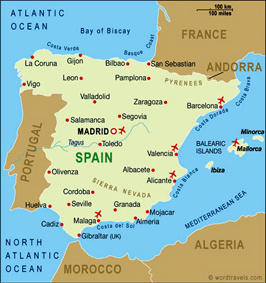
A Francisca tells in a forum on internet the name El Palé was invented by a Francisco Leyva Vances in the
late nineteenthirties. It comes from Paco (other name for
Francisco) and Leyva. Paco was born in Malaga and died very young.
To patent El Palé his sister had to sell the best stamps of a very important collection that she and her little brother had.
Monopoly (read: Waddingtons-UK) started a lawsuit against him for plagiarism
and his surviving relatives, more accurate his sister, won the lawsuit. (Note:
I have the feeling there was more likely a close cooperation and Waddingtons
allowed him a Spanish patent, because the game is almost an exact copy of the
London game board. albert)
In the beginning El Palé was made at his (or her) home and afterwards in game factories.
Till about 1960 the game was issued
under the name El Palé and was according the Waddingstons
design, i.e. with the green locomotive
pointing backwards and the names of the properties mentioned twice on the
spaces.
From about 1961 on Parker Brothers copyrighted Monopoly appeared
on the game boards and of course the design became American style as well,
i.e. with black locomotives, a blue
treasure chest and a gold ring on "Impuesto de lugo".
From that moment on two versions were
issued. viz. one with the streets of the country's capital city Madrid
and one with the streets of the county capital of Catalonia Barcelona.
It turns out monopoly-like games of inland make to be in a
number of countries all over the world, mostly better known than the Parker
Brothers/Hasbro edition, also available since second half of the 20th century,
next to the inland versions. Except for Spain the countries are:
| * Argentina: Estanciero |
* Hungary: Capitaly |
| * Austria: Das Kaufmännische Talent DKT |
*
Mexico: Turista |
| * Brasil: Banco Imobilíario |
* Norway: Millionær |
| * Denmark: Matador |
* Russia: Manager |
From Salida onwards all spaces (with streets from Madrid)
of the Waddingtons
layout of El Palé are:
Calle de Curtidores - Sorpresa - Calle
de Leganitos - Impuesto de utilidados - Estación del Norte - Calle
de la Princesa - Suerte - Calle de Sta.
Engracia - Calle de Bravo-Murillo
- Cárcel - Calle de S. Bernardo - Electriçia
Madrilena - Calle de Toledo - Calle
de Atocha - Estación del Medodia - Calle
de Carretas - Sorpresa - Calle de Arenal
- Carrera de S. Jerónimo - Parada libre
de pagos (Free Parking)
- Calle de Goya - Suerte - Calle
de Velazquez - Calle de Serrano -
Estación de las Delicias - Plaza
de Oriente - Plaza
Mayor - Canal de Lozoya - Puerta
del Sol - De aqui a la Cárcel - Paseo de la Castellana
- Paseo de Pecoletos - Sorpresa - Paseo del
Prado -
Estación de Getafe - Suerte - Calle Alcalá
- Sobre tasa (additional charge) and Gran
Via.
From Salida all spaces (with streets from Madrid) of the Parker Brothers
layout are:
Ronda de Valencia - Caja de Comunidad - Plaza
Lavapiés - Impuesto sobre el capital - Estación de Goya - Glorieta
Cuatro Caminos
- Suerte - Avenida Reina Victoria - Calle
Bravo Murillo - Cárcel/Sólo visitas - Glorieta
de Bilbao - Compañía de electricidad - Calle
Alberto Aguilera - Calle Fuencarral -
Estación de las Delicias - Avenida Felipe II -
Caja de Comunidad - Calle Velázquez - Calle
Serrano - Parque Gratuito (Free Parking)
- Avenida de América - Suerte - Calle
María de Molina -
Calle Cea Bermúdez - Estación del
Mediodía -
Avenida de los Reyes Católicos - Calle
Bailén - Compañía de aguas - Plaza
de España -
Vaya a la Cárcel - Puerta del Sol - Calle
Alcalá - Caja de Comunidad - Gran Vía - Estación
del Norte - Suerte - Paseo de la Castellana and Paseo
del Prado.
From Salida all properties of the Parker Brothers layout of Barcelona
are:
Calle Lauría - Calle
Rosellón - Estación Ferrocarriles Catalanes - Calle
Marina
- Calle Urgel - Calle
Consejo de Ciento - Cárcel/Sólo visitas - Calle
Muntaner
- Compañía de electricidad - Calle Aribau -
Avenida Infanta Carlota - Apeadero Paseo
de Gracia - Paseo de San Juan - Calle
Diputación - Calle Aragón - Parque Gratuito -
Plaza Urquinaona
- Calle Fontanella - Ronda
San Pedro - Estación de Francia - Ramblas -
Vía Layetana - Compañía de aguas
- Plaza Cataluña - Vaya a la Cárcel - Avenida
Puerta del Ángel - Calle
Pelayo - Vía Augusta - Estación
de Sants - Calle Balmes and Paseo
de Gracia.
 Edition: El Palé (Monopoly) -
silvery box Edition: El Palé (Monopoly) -
silvery box
Juego
de sociedad (Society game/Community game)
"Patentado
y registrado con los números 122914 y 1250"
Publisher: Manuel Gimenez Reyna -
Malaga, Alcalá (?) - ±1950
Dimensions of the box: 25 x 25 cm
The game:
The dictionary gives for El Palé:
"Table game played on a game board with counters (read:
tokens) moved in harmony with the throws of a die aiming the purchase of
real estate corresponding to the various spaces of the board". So for short:
Monopoly.
A Spanish friend tells by tradition:
"In the fourties they were very poor and the average Spaniard certainly had
no board game at home at which money is required. Those who could play El Palé
where the rich. So it merely was a society game (as the picture on the
lid suggests) rather than a community game."
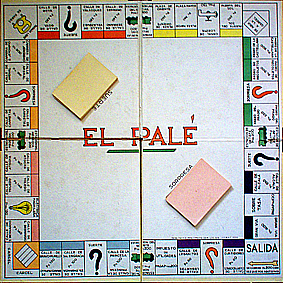
José Varela from Santander is the owner of the set shown. It was bought in the then
"Casa Palacios" store in Santander, as the gold sticker on the lid says.
All attributes as well as the double folded solid game board are in the innerbox
that is divided into 3 sections
by cardboard partitions.
There are a few minor deviations from the Waddingtons board design, i.e.:
 |
the jail is empty (no rascal behind the bars). |
 |
the car on the Free Parking corner is yellow
instead of red. |
 |
there is no policeman on the 3rd corner. |
 | the Suerte spaces on the board show a blue
question mark while the Sorpresa spaces show a red
question mark in
mirror image. |
 | the Bulp on the Electriçia
Madrilena space differs from the Waddingtons model. |
 | the same for the Tap on the Compañía de aguas space. |
The Suerte cards are yellow
through, the Sorpresa cards pink.
The banknotes are from "Juego Palé", printed in
color on white paper in the denominations:1 - 5 -
10 - 20 -
50 - 100 and 500.
The back side of the notes only show "Juego Palé" in large characters
in a decoration.
The tokens are 6 colored plastic discs. The houses
and hotels have an A-shape and are of glossy
wood.
One of the dice is blue green, the
otherone of unprepared wood, both with white pips. However, it is very well
possible they are not the original ones.
 Edition: El Palé
- Juego
de sociedad -
yellow box Edition: El Palé
- Juego
de sociedad -
yellow box
Compra
- Venta - Negocia (purchase - sale - trade)
Publisher: Manuel Gimenez Reyna -
Malaga, Alcalá (? )- ±1960
Dimensions of the box: 25 x 25 cm
The game:
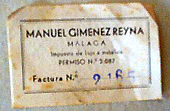 This set is also from the collection of José Varela. He even played it
broken as a teenager. It was bought by his parents in about 1965, so reason to
assume this set to be published about 1960.
This set is also from the collection of José Varela. He even played it
broken as a teenager. It was bought by his parents in about 1965, so reason to
assume this set to be published about 1960.
Except for the more cheerful and modern image on the lid
(the perfect
family: father, mother daughter and son playing monopoly) furthermore only small
differences have been introduced, like the Suerte cards that are pink
through and the Sorpresa cards blue green.
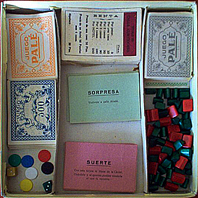
All other accessories remained unchanged, like the banknotes,
the colored plastic discs for
the tokens and the wooden houses
and hotels
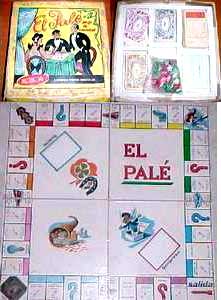 Edition: El Palé
- Juego
de sociedad Edition: El Palé
- Juego
de sociedad
"Patentado y registrado con los números 122914 y 1250".
Publisher: Manuel Gimenez Reyna -
Malaga, Alcalá (?) - ±1960
Dimensions of the box: 25 x 25 cm
The game:
Both illustrations on the lid as well as the game board and the
white plastic insert in the innerbox makes assuming this edition to
be published somewhat later than the silvery-
and yellow-box
however, a more accurated year cannot (yet?) be given.
On the other hand the green engines
disappeared from the stations and the corners are a bit nicer
illustrated.
All this is why I believe this edition is from what I call the transition
period in which the input of Parker Brothers came in and that of Waddington
slowly disappeared..
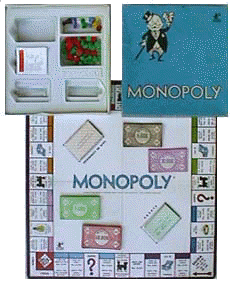 Edition: Small box
- Barcelona, ref. 7477-B Edition: Small box
- Barcelona, ref. 7477-B
- Madrid, ref. 7400-M (?)
Publisher: Parker Bros.Inc./Juguetes Borrás - Mataró -1961
Dimensions of the box: 26 x 26 cm
The game:
Right from the the introduction of Parker Brothers' new patent of 1961 the inland manufacturer Borrás
made the Monopoly games
for Parker Brothers until Hasbro, with its own manufacturing facilities in
Ireland, took over in 1993.
This set in the small blue box immediately
attracts attention because the word Monopoly on the centrefield of the game
board is blue as well.To fit in the small
box the soft board, with white back and black border, is folded twice. The
necessary cut is perpendicular to side 2 and so intersects the word Monopoly.
The insert of the inner box is of soft, white plastic and has 6 trays.
This edition clearly has the symptoms of the transistion period as there are:
 |
black Parker Brother's engines on the station
spaces. |
 |
gold ring on the Super Tax space. |
 |
the blue treasure
chest on the Caja de Comunidad field. |
 |
the street names and prices are mentioned twice on all
properties, which is typical for Waddingtons. |
Further this issue shows that:
 |
The game board is white. |
 |
The spaces on the board (and the property cards) are numbered. Here the to
the properties adjacent spaces are stated by "bis". |
 | The rent of the unbuilt most expensive yellow
street is the same (2.200 ptas) as of the 2 other streets, where it
should be slightly higher. |
 |
The prices of the properties are given in Ptas. (Pesetas). In
later editions there is only Precio (Price). |
The numbered Suerte (Chance) and Caja de Comunidad
(Community Chest) cards are white with recurring print Monopoly resp. in green
and beige. The single sided
printed banknotes are in but 6 denominations, viz.: 100
- 500 - 1.000
- 5.000 - 10.000
and 50.000.
They do show a house and an engine but have no reference to any patent and
deviate strongly from the well-known Monopoly money.
The houses and hotels are made of mat plastic and have no roof edge nor a chimney. The 6
colored tokens are plastic aggravation pawns. The two white dice
are very small, sides of 10 mm.
The issue here described is the Barcelona edition. It is quite
probable there is also a Standard issue (so with long box) as well as a Madrid
edition in both versions.
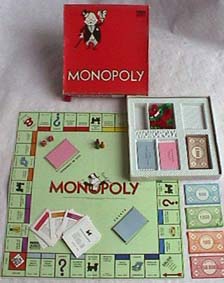 Edition: Small box
- Madrid, ref.nr. 001101-M Edition: Small box
- Madrid, ref.nr. 001101-M
- Barcelona, ref. 001100-B (?)
Publisher: Parker Bros.Inc.USA/GMJ, S.A. - Madrid - 1982/85
Dimensions of the box: 25.7 x 25.7 cm
The game:
The game board of this set shows as latest date 1985 and the Rules 1982. The
presentation, with cheerful Uncle Pennybags in the left upper part and Monopoly
in the lower part of the lid, is still exactly identical to the one of 20 years
ago. GMJ stands for General Mills Juguetes, apparently the Spanish
opposite of the American company who owned Parker Brothers from 1968 till 1985.
Differences between this issue and the small box of twenty years ago are:
 |
The soft game board (with white back) is in the well-known blue
green color. |
 |
The word Monopoly is in red on the
midfield, parallel to side one. Also Uncle Pennybags with stick appears from the middle O. |
 |
The cut in the board is now perpendicular to the word Monopoly. |
 |
The street's name and price are only mentioned once. |
 | There is no black border along the game board. |
 | The rent of the unbuilt most expensive yellow
street is the same (2.200 ptas) as of the 2 other streets, where it
should be slightly higher. |
 |
The prices of the properties are mentioned as Precio (Price)
without any denomination. |
 |
The insert in the inner box is again of soft white plastic, but now
two the six trays are very shallow. |
 |
The Suerte and Caja de Comunidad cards are now of
solid blue and pink
paper. |
 |
There are now banknotes in 7 denominations, viz.: 100
- 500 - 1.000
- 2.000 - 5.000 -
10.000 and 50.000. |
 |
The green houses and red
hotels are made of glossy plastic and do have a roof edge as well as a
chimney. |
 |
The tokens are aggravation pawns again, but made of wood. |
 |
The dice are red and a little
bit bigger, having sides of 11 mm. |
The issue here described is the Madrid edition. It is quite probable
there is also a Standard issue (so with long box) as well as a Barcelona edition
in both versions.
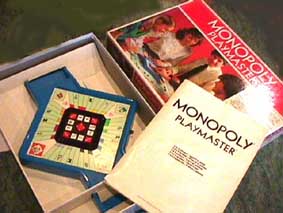 Edition: Monopoly
Playmaster, without ref.nr. Edition: Monopoly
Playmaster, without ref.nr.
"Electronic Accessory for a Faster Paced Game"
Publisher: Parker Brothers - Beverley - MA - 1982
Dimensions of the box: 8.0 x 28.4 x 40.5 cm
The game:
This remarkable accessory adds 3 specialties to the Monopoly game:
-
Auctions for players to collect properties more quickly.
-
Buyback, through which it becomes possible to buy a color group as
a whole.
-
Loan, to build houses and hotels faster.
The basic Rules remain unchanged. The bank, the gameboard, the cards,
everything keeps the same meaning. Playmaster however, with its exciting new
lights, sounds and electronic dice adds an extra
dimension.
To use Playmaster it is placed on the centre of the gameboard in such a way that
its Chance and Community Chest holes falls over the corresponding spaces on the
board. Next the 9V power pack is to connect. Before the start of the game
players have to become familiar with those quite a few noices and melodies like:
 |
Start of the game |
|
We're in the Money
|
 |
Double throw |
|
Merrily we roll along
|
 |
Chance- and Community Chest |
|
Beethoven's piano sonata
|
 |
Go to Jail |
|
Siren
|
 |
Loan |
|
We're in the Money
|
 |
Call Loan |
|
Beethoven's 5th Symphony
|
 |
Auction |
|
16 high wheezes
|
 |
Buyback |
|
Schubert's Lieder
|
 |
Free Parking |
|
The Circus march
|
 |
Income-/Super tax |
|
Framboze
|
 |
Station |
|
I've been working on the railroad
|
 |
Bankruptcy |
|
Taps
|
 |
Passing GO |
|
Charge
|
This interesting instrument was in Europe also sold in The
Netherlands and Belgium (ref.nr.0500073) - Germany (ref.nr. 1005) and France
(ref.560020).
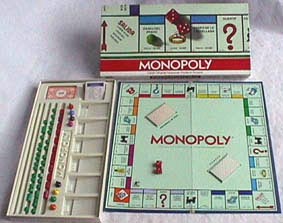 Edition: Standard -
Madrid, ref. 001115-M Edition: Standard -
Madrid, ref. 001115-M
- Barcelona, ref. 001114-B (?)
Publisher: Parker Bros.Inc.USA/PBP. S.A. - 1982
Dimensions of the box: 26.3 x 51.0 cm
The game:
The game board of this issue shows as latest date 1974 and the Rules as well as
the rim of the lid 1982. As in other European countries with this issue a much
colorful presentation is introduced. Above the red
bar with Monopoly in white characters is now Salida (Start) with at the
right another 4 spaces and beyond Salida still a part of the "Ronda de
Valencia", the first space.
However, none of these properties is built on. There is no picture on the bottom
of the box neither.
The solid game board has a dark blue
back, intersected by a striking white ribbon connecting both parts. The fold is
perpendicular to side one. On the centrefield is Monopoly in red
characters, however without Uncle Pennybags. Next to the Jail corner is
the Borrás logo?!
The rent of the unbuilt most expensive yellow
street is the same (2.200 ptas) as of the 2 other streets, where it should
be slightly higher.
The special insert of the inner box is of beige
(sometimes red) plastic with 5 grooves to
conveniently place the property deeds. There are only 6 trays with the
denomination in relief for the 7 banknotes. But next to the tray for the
houses and hotels is another one that can also be used for a banknote. These banknotes
are still "typical Spanish". The numbered Suerte and Caja de
Comunidad cards are white again with recurring print Monopoly resp. in green
and beige. The
houses and hotels
are of glossy plastic
and do have a chimney as well as a roof edge. The 8 colored tokens are
hollow pawns on a broad, high base. The red
dice have the normal shape.
The issue here described is the Madrid edition. However, the Barcelona
variant is identical.
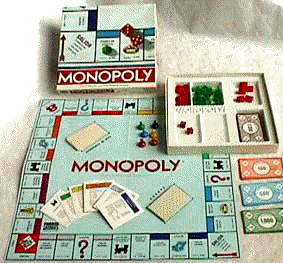
Edition: Small box - Barcelona, ref. 001112-B
- Madrid, ref. 001113-M(?)
Publisher: Parker Bros.Inc.USA/PBP.S.A. - 1982
Dimensions of the box: 25.7 x 25.7 cm
The game:
There but some minor differences compared to the Standard edition, viz.:
 |
The color of the soft game board (with white back) is blue grey. |
 |
Next to the Jail corner is now Parker with logo. |
 |
The red dice have sides of 11 mm again. Small box - small dice. |
The issue here described is the Barcelona edition. However the Madrid
variant is identical.
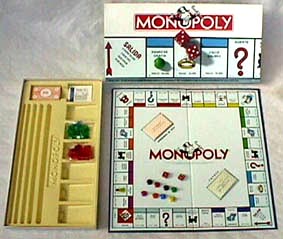 Edition: Standard
- Barcelona, ref. 6300-B Edition: Standard
- Barcelona, ref. 6300-B
- Madrid, ref. 6300-M
Publisher: Parker Bros./Borrás Plana S.A. - Mataró - 1985
Dimensions of the box: 26.3 x 51.0 cm
The game:
The design of this issue looks very much like the one published in 1982. However,
the lid is a bit less colorful but shows the red
bar with Uncle Pennybags, now on top of the last part of the
4th side. In 1985 this presentation is also published in a large number of other
countries, f.e. Holland and France. However, there is no picture at all on the
bottom of this box.
The playside of the very solid game board is very
light blue, the back is now uniform dark
blue. On the midfield is Monopoly in red
characters with Uncle Pennybags, but not in a bar or frame. It is striking that
the color of the 2nd group of properties in not light
blue but grey. The color of the
first group is very dark blue.
The rent of the unbuilt most expensive yellow
street is the same (2.200 ptas) as of the 2 other streets.
For the rest the attributes of this edition are exactly the same as those of the
1982 issue.
The issue here described is the Barcelona edition. However the Madrid
variant is identical.
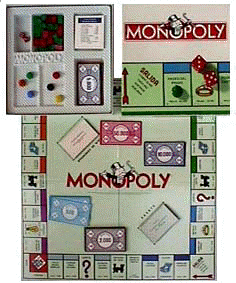
Edition: Small box - Madrid, ref. 6366-M
- Barcelona, ref. 6366-B
Publisher: Parker Bros./Borrás Plana S.A.- Mataró - 1985
Dimensions of the box: 25.7 x 25.7 cm
The game:
The execution of this variant is precisely equal to that of the Standard edition,
except for the board of soft cardboard. But even the first and 2nd group of
streets have again those deviating colors. Also the color of the game board is
slightly greener.
And … small box, so … small dice.
The issue here described is the Madrid edition. However, the Barcelona
variant is identical.
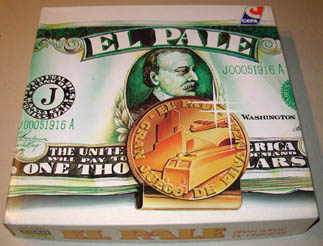 Edition:
El Palé - square box, EDAD-9-90, Nr.14.3601 Edition:
El Palé - square box, EDAD-9-90, Nr.14.3601
Gran juego de finanzas
Publisher: Cefa Toys S.A. - La Muela -
Zaragossa - Spain - 1985
Dimensions of the box: 25 x 26 x 4 cm
of the board: 48 x 48 cm
The game:
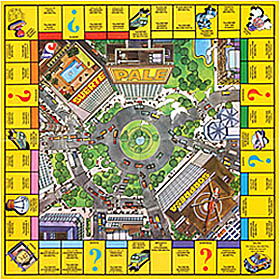 This edition is owned by Eugen Bruhin - Basel - CH since he bought it in
1985.
This edition is owned by Eugen Bruhin - Basel - CH since he bought it in
1985.
Apparently Cefa Toys
(irregularly) continued making El Palé editions after Manuel Gimenez Reyna de
Malaga, see 1995 and 1999.
Probably the patent on this game has been expired and this company re-introduced
it in a more modern look.
The properties of the game have not been changed since 1960, but its
presentation is much nicer.
This version shows a "village square" in the game boards' midfield, surrounded by modern buildings,
like an appartment building with swimming pool for the Suerte cards and a
appartmint building with a heliport on top, for the Sorpresa cards. Another
apartment building has a large sky-sign (?) of PALE.
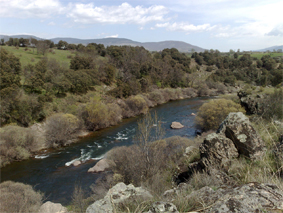 Deviations
with regard to earlier editions: Deviations
with regard to earlier editions:
 |
You start from Salida by taxi. |
 |
All prices became a factor 1000 higher. |
 |
Estación de Getafe, with the geen
Waddingtons engine, has been replaced
by the airport Aeropuerto de Barajas, with an image of a little
plane. |
 |
On the other 3 stations only the green
Waddingtons engine has been replaced
by a modern diesel engine. |
 |
There is a rascal in the jail now. |
 |
The Bulb on Electriçia
Madrilena field is totally different from both the old
game board and that of the Waddingtons model. |
 |
On the Canal de Lozoya-space the poor tap has been
replaced by a solid valve. (The Lozoya river is an important
water catchment
area for Madrid city.) |
 | "De aqui a la Cárcel" became here "A la
Cárcel". |
 | The comic image on the Go-to-Jail-corner is supposed to be
a judge. |
Other features of this version are:
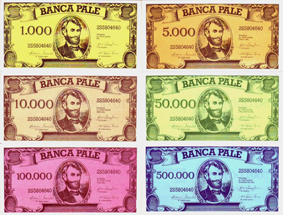
 |
The light grey back of
the game board is printed in a repeting pattern of "el pale". |
 |
The property deeds are printed on solid, white paper.
The costs of the rent on a property are printed on a colorfield
as from the
color bar of the street. |
 |
The Suerte and Sorpresa cards are also printed
on solid, white paper. |
 |
The hollow houses and hotels
are of plastic. |
 |
The 6 tokens are moulded, plastic discs. |
 | The banknotes are of the Banca Pale and are printed
in color on white paper. The 6 denominations are: 1.000
-
5.000 - 10.000
- 50.000 - 100.000
and 500.000. |
 |
Both dice are light green
blue and have white pips. |
 |
At the end of the Rules the address of CEFA is
given as: Celulosa Fabril S.A. - Paulina Savirón, s/n - Zaragossa. |

This picture, found on ebay, shows there has also a long box been
published.
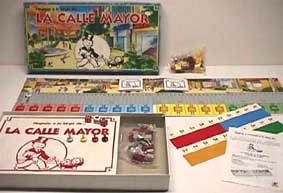 Edition: La Calle Mayor (Main Street), Ref.8710 Edition: La Calle Mayor (Main Street), Ref.8710
Publisher: Parker Brothers/Borrás - 1985
Dimensions of the box: 23.5 x 44.8 x 5.4 cm
The game:
The comment to this game says "Trade and build along the ... " while
the "Cartas Fortuna" show an illustration of Uncle Pennybags on
the back. This are sufficient reasons to add this game, in 1985 issued by Parker
Bros., to the collection of Monopoly like games. The idea however differs
considerably from Monopoly:
The board is oblong: 21,5 x 85,5 cm and contains 4 colored groups of 5
spaces each, of which the maximum of 4 players have to collect the properties
cards. The 4 tokens are simple collored plastic pawns.
Of the 3 dice 2 are red with white
pips. The third one is white and provided with a F (Fortuna) and C
(Construir) and the colors of each of the 4 spaces on the other 4 sides.
Furthermore are 80 hotel units, 20 per color of the tokens. Dependent on
the number of players each player gets 14 to 20 hotels. He is to build these,
subject to the number of pips thrown, on spaces at choice. The Cartas Fortuna
will help.
The token is always put on the space relating to the total of the property cards
the player possesses. Player can no longer take part when he has no more hotels.
Winner is of course the one who finally has most properties.
The white bottom of the box shows the long game board in black and
white.
Identical games are Advance to Boardwalk (USA), Schossallee
(Germany) and Ga verder naar Kalverstraat (The Netherlands).
The price amounted to Ptas. 2250 (€ 12,86) July 1995.
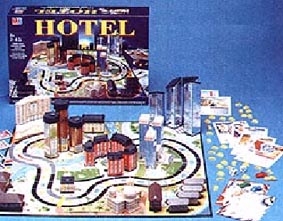 Edition: Hotel, ref.14313 Edition: Hotel, ref.14313
Publisher: MB
Juegos/Hasbro Int., Inc. - 1986
Dimensions of the box: 27
x 40 x 9 cm
The game:
The box of this game is rather voluminous because quite a lot of room is
necessary for the 8 hotels, the bank building and the town hall.
The buildings of hotel President and Fujiyama are already
skyscrapers.
On the game board a circuit is set having a black edge on each
side to put the yellow
Entries for
the hotels on. Opposite the Bank is a yellow
line, where you receive "your salary" on passing by. The yellow
line opposite the Town Hall entitles to buy Entries.
The spaces of the circuit mainly consitst of Purchase On landing on a Purchase space you are allowed to buy a property
adjacent to one of the sides of that space.
On a Building Licence space you are to throw the special die:
Red = you don't get the Licence
Green = you have to build now
H = building is free of charge
2= building cost twice the normal price
Except a main building you also can enlarge with annexes and "Facilities".
The most luxury hotel is finally (!) Waikiki with 4 Extensions and all
Facilities, what makes it a 5-star hotel. The simplest hotel is called Boomerang
and has besides the main building only Facilities (max. 2 stars).
The 4 players obtain their revenues from the other players the moment
they land on a space with an Entry of one of their hotels. To that end the
player throws the normal die again. The number of pips = the number of nights
he has to stay in the hotel. The price for it depends on the number of stars of
the hotel.
The winner finally possesses all hotels.
A very nice game that really do belong to the collection of each Monopoly
games collector.
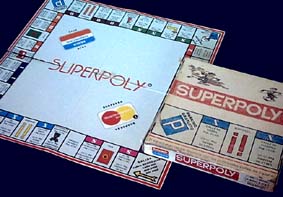 Edition:
Superpoly® , REF. 1000 Edition:
Superpoly® , REF. 1000
"El super juego de las finanzas con las principales calles del País"
Publisher: Falomir
Juegos/Jufasa -
1989
Dimensions of the box: 25.7 x 25.7 x 4.7 cm
of the game board: 48.5 x 48.5 cm
The game:
Dit set is owned by Alejandro Vergara - SP.
It is the cheaper edition, strangly enough with the same
Ref.Nr.1000, of that of the "De Luxe" version, as it was published
in ±1994.
The streets are all often occurring in Spanish cities.
Differencers are a.o.:
 |
There is no blue arch
with 'De Luxe' on top the red bar of the
lid. |
 |
The game board is of soft cardboard. |
 |
The board's midfield doesn't show the illustrations as are
on top the red bar of the lid. |
 |
The 2 X- spaces on the
lid are also blue on the lid. |
 |
The banknotes are in Pesetas. |
 |
The amounts on the spaces and property deeds are in
Ptas. |
All other items (Chance and Community Chest cards, tokens, dice)
are the same as from the 'De Luxe édition.
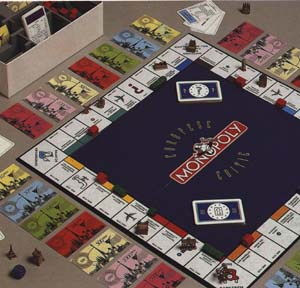 Edition: European
Edition - Spanish Edition: European
Edition - Spanish
Publisher: Parker/Tonka/Hasbro - 1991
Dimensions of the box: 27 x 27 x 8.4 cm
The game:
Although I have not yet seen this edition it is very likely that this game does
exsist in Spanish, because Spain is one of the 12 countries of the European
Community. Besides one of 12 very nice tokens is of La Sagrada Familia,
a very special temple in Barcelona, the construction of which was started
in 1882, but that is still not finished, because it may only be
financed from donations. The other 11 tokens are:
Blarney Castle (Ireland), Brandenburger Tor (Germany), Abby of Clervaux
(Luxemburg), Atomium (Belgium), Parthenon (Greece), Eiffeltower (France),
Grundvig Church (Denmark), Leaning Tower of Pisa (Italy), Torre de Belem
(Portugal), Tower of London (England) and of course a windmill for The
Netherlands.
The properties are well-known streets in the joining countries, viz.:
 |
Denmark: Strandvejan - Slotsgade |
 |
Belgium: Louizalaan - Beenhouwersstraat -
Grote Markt |
 |
The Netherlands: Coolsingel - Lange Poten -
Kalverstraat |
 |
Spain: Paseo de la Castellana -
Gran Vía -Las Ramblas |
 |
Greatt Britain: Oxford St. - Piccadilly -
Park Lane |
 |
Italy: Via Veneto - Via Condotti -
Via Monte-Napoleone |
 |
France: Avenue Foch - Avenue des Champs-Elysées -
Rue de la Paix |
 |
Germany: Königsallee - Kurfürstendamm |
The 4 stations are replaced by airports of the countries:
Luxemburg - Portugal - Greece and Ireland.
In the period this game was launched on the market it was believed that the European
currency would become Ecu. That is why there are 7 banknotes
with this game, all having the same illustration, in the denominations: 10
- 50 - 100
- 200 - 500
- 1000 and 5000
Ecu. The back shows Ecu in a black circle with 12 stars. Because "investments
are internationally done a large amount of money is necessary" and that is
why there is twice as much money with this issue. The bankers tray of this game is
a black plastic insert with 13 holes.
The backside of as well the Chance- as the Community Chest cards
are blue. In the stars circle is a ? with
Chance and with the Community Chest cards …. a Belgian Ecu coin. The green
houses and red hotels are made of glossy wood
and do have a roof edge. The dice are blue
and their pips a again stars of course.
This set was made in "Waterford, Republic of Ireland".
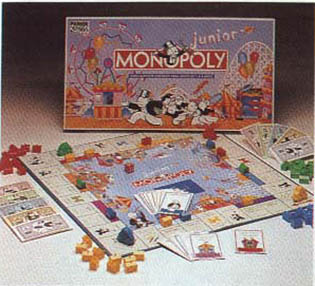 Edition: Junior
standard - Spanish, ref. 690261 Edition: Junior
standard - Spanish, ref. 690261
Publisher: Parker Brothers/Tonka - 1991
Dimensions of the box: 23.5 x 46.3 cm
The game:
Just like in the regular Monopoly game the aim is to collect as much money as
possible. At the moment one of the players runs out of money the other players
must count up their money to see who has won the game. The game will be finished
in 20 to 30 minutes.
The back of the board is blue,
like the tray in the box. The game board in folded vertically. On the
bottom of the box is a black and white picture of the board and all attributes.
The money consists of one side printed notes of 1 to 5 with Uncle
Pennybags in various situations the centrefield.
Four children can play at the same time, because there are 4 cars,
respectively yellow, red,
blue and green.
The ticket booths are to be distributed amongst the players with the same
color of car. In the coarse of the game ticket booths can be bought to place on
an amusement so that it becomes your property. If you also own the other
amusement of the same color, one must pay double the amount shown on the space.
There are 6 Chance spaces where cards can be drawn with instructions like
"Go to the water chute". The dimensions of these tickets are: 55 x 84
mm.
The game was manufactured in France.
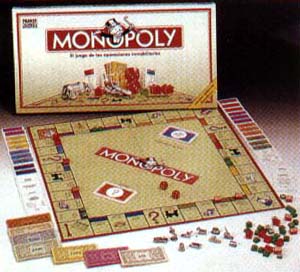 Edition: Standard
- Madrid, ref. 06951e Edition: Standard
- Madrid, ref. 06951e
- Barcelona, ref. 06951SP
Publisher: Parker Bros./Borrás - 1992
Dimensions of the box: 26 x 51 cm
The game:
On the lid of this standard box is again a picture of the "collected
attributes" on a perspective board. At the bottom of the box is a color
picture of the laughing family, but they looks to eachother instead of to the
game.
It is in this issue for the first time that the "red bar with Uncle
Pennybags" appears on the centrefield of the game board.The back
side of the board is red. The plastic insert
of the innerbox contains 7 holes for the banknotes as well as 5 otherone's. The money
consists of banknotes with the denotation Monopoli - Monopoly - Monopol and the
statement "© 1992 Tonka Corporation"
The rent of the unbuilt most expensive yellow
street is now higher (2.400 ptas) than of the 2 other streets, as it should
be.
The Chance cards have a red back with
a ? and the Community Chest cards a blue
back with treasure chest.The tokens are of heavy metal.
The plastic houses do have a
chimney, the hotels haven't.
These sets were made in Ireland.
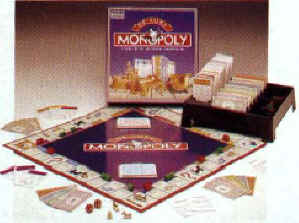 Edition: Monopoly
Deluxe, ref. 14167 Edition: Monopoly
Deluxe, ref. 14167
Publisher: Parker Bros./Tonka Corp./Hasbro -1993
Dimensions of the box: 26.9 x 26.9 x 8.4 cm
The game:
This is indeed a very luxury and sound issue of the game.
The lid shows a picture that has great resemblance with the one of the standard
issues with ref. number 06951, but still deviating: Besides the 3
"gold" tokens (boat, hat and car) is a stack again of banknotes and of
some property cards, but only one house and one hotel are put on a part of the
4th side of the game board.
The sound game board has a red
back and is folded twice. It is situated on a very practical, black insert
of hard plastic, in which besides the 7 holes for the banknotes, 2 for the
hotels and houses also is one in which the banker's property cards can be placed
upright. The Chance cards have a red
back with a ? and the Community Chest cards
a blue back with treasure chest.There are
twice as many banknotes, as happen more often with special editions of
Monopoly. The notes are of the new design, this means a.o. without any mention
of copyright and with 3x a mention of the value. The houses and
hotels are made of nice
glossy wood.
One glance on the picture at the bottom of the box shows what is described above.
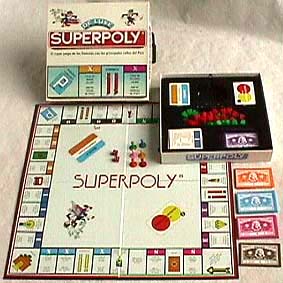 Edition:
Superpoly®De Luxe, ref. 1000 (1) Edition:
Superpoly®De Luxe, ref. 1000 (1)
"El super juego de las finanzas con las principales calles del País"
Publisher: Falomir Juegos/Jufasa - ±1994
Dimensions of the box: 25.7 x 25.7 x 4.7 cm
The game:
As the name does suggest this set (in a white box) is very much like
"the well-known Property Trading Game". The subtitle of this game says
that the properties are "important streets of the country". After
comparison with both Monopoly game boards it turns out that there are at least
streets from Madrid and Barcelona.
Maybe you recognize from which cities the other streets are, because from Salida
on they are:
Av. de Cataluña - Calle de Calvo Sotelo -
Estación de Ferrocaril - Calle de
Brasil - Av. Alfonso XIII - Calle de Pizarro -
Calle de Bilbao - Calle de Buenos
Aires - Calle de las Delicias - Estación
de Autobuses - Calle de Goya - Calle de Velázquez
- Calle de
Serranos - Plaza de América - Calle de Balmes -
Calle de Colón - Estación de
- Av.del Cid -
Ramblas - Calle de la Paz - Calle
de Bailén -
Calle de Alcalá - Gran
Vía -
Estación - Av. Onésimo and G.V.Fernando el Católico.
Besides the groups of properties are indicated by colors each color also has a
character. The purpose of this is not clear.
The Jail, Free Parking and "Officer Edgar Mallory" also appear in this
game, but the illustrations are different. The stations are resp. a
Railwaystation, a Busstation, a Filling station and a Space station. There is
even a kind of Rich Uncle Pennybags, a laughing man literally chucking his money.
The lid shows 4 spaces randomly put together, viz.
-
2 streets from the light blue group,
however with the wrong colors
-
the P-corner
-
the Sorpresa space with ¡! from the 4th side
This combination of 4 spaces is repeated on the lid of all later versions of
Superpoly.
The solid game board has a black back and is folded twice. The
game board's midfield shows Superpoly® in closed, red
characters, parallel to the 1st side.
There are 16 Tarjeta Sorpresa- (Surprises-) and as many Tarjeta
Caja (Safe) cards, the instructions of which will sound familiar to the
avid Monopoly player, like the Street Repairs and the Get out of Jail Free.
The insert of the innerbox
is of thin black plastic and has 6 holes. The bottom of the box shows only text
under the name bar, printed in blue. So no
picture of the game board. The 6
different Superpoly banknotes have following currencyless
denominations: 200
- 1.000 - 2.000
- 10.000 - 20.000
and 100.000. They are one-sided printed on
white paper.
There are 32 houses and 18 hotels of dull plastic, without roof-edge but with chimney. They are
connected to eachother by thin treads. The 6 tokens are
plastic pawns.
The red dice with
white pips are small again, with sides of 10 mm.
This edition is called De Luxe because:
 |
the board is made of solid cardboard. |
 |
all cards are properly cut and on stacks in the box. |
 |
the plastic insert of the innerbox can be used as "banker's
tray". |
The price of this set amounted to Ptas.1985 (€ 11.35) December 1995.
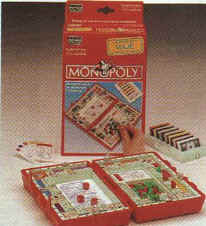 Edition:
Monopoly Viaje, ref. 14248 Edition:
Monopoly Viaje, ref. 14248
Publisher: Parker/Hasbro - 1994
Dimensions of the box: 5 x 12 x 18 cm
The game:
The red outer box clearly shows a
picture of the inside of this red case.
This variant is a well-reflected and practical travelling companion indeed. The tokens
can be fixed on each space but not more than just one. That means that the next
player landing on the same street has to move one step further. Only on
the corners is sufficient space for 4 players to stay. There are also 4 holes
per street for the houses and hotels.
There are no Chance nor Community Chest cards. Instead three dice
have to be thrown and the instruction mentioned in the table with the
corresponding number to be carried out.
Instead of a free ticket to leave Jail you get one of the 6 keys. For the
rest the rules are the same as those of the standard edition.
These red cases were made in China.
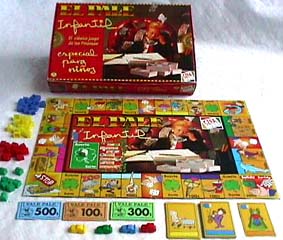 Edition: El
Palé
Infantil, Nr. 11.9001 Edition: El
Palé
Infantil, Nr. 11.9001
"especial para niños"
(special for
children)
Publisher: CEFA Toys
S.A.- Zaragoza - 1995
Dimensions of the box: 26.7 x 36.7 x 6.0 cm
The game:
Like in Junior variant of the "world-famous game" the inland
manufacturer of this "edition for kids" also chose for funfair
attractions with houses in 4 colors red,
yellow, green
and
blue. The maximum 4 children can
choose from plastic cars in the same colors.
The oblong game board (35 x 50 cm) has 10 spaces along the long sides (1
and 3) and only 6 on the short sides. Only on each of the long sides are 3 Suerte
fields, again exactly the same as in the Junior Edition with oblong board of 1996.
(Does this mean that Parker Brothers have copied the Cefa
design?). On these Luck spaces, with green
cloverleaf, a card of the concerning stack must be taken.
Typical for this game is that these Luck cards only show pictograms,
the explanation of which is given on the game board next to the stack. Even this
is not necessary because it is obvious that "a hand receiving money"
means you'll get money and a pointing finger = go to … . Only the pictogram
"cheerful laughing peanut behind a shopping trolley" on top of
a bar of a certain color, requires the comment that one may put a house of his
own color on a space with the color of the bar. When there are already two of
different color you are allowed to replace one. But … when there are two of
the same color you are not allowed to put your house but you may pull
another card.
There are no trains (where you may throw a second time), however there are 4
spaces … where one may throw a second time! Rich Uncle Pennybag's change
corner is here a V.I.P-figure juggling with dollars of whom you also may keep
the money present.
The game is played with dollars. The small banknotes (45x80 mm) are in
the dominations 100 – 200 – 300 – 400 and 500 $. Over or on Salida you
receive 200 $.
The Rules are printed on the bottom of the box of which the lid is part
of.
The price of this set amounted to Ptas.1850 (€ 9.08) June 1999.
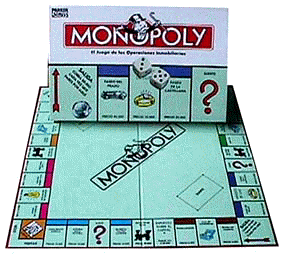 Edition: Standard -
Madrid, ref. 14535 Edition: Standard -
Madrid, ref. 14535
-
Barcelona, ref. 14535 (?)
Publisher: Parker/Tonka/Hasbro - 1996
Dimensions of the box: 26.8 x 40.3 x 5.3 cm
of the dubble folded board: 25.2 x 25.2 cm
The game:
This edition is a sample of the "new look" of the games who are
manufactured in the Irish works. The fresh white box shows a red
bar and a part of the fourth side of the board on the cover. The new
dimensions of the boxes are standardized for all of their games Hasbro told.
So herewith the long box we called standard so far disappears.
This new box contains a red plastic tray
insert with newly shaped slots for the banknotes and title cards of the banker.
The board is folded in four like in the so-called "small box".
The back side is red and the play side is blue
green. The set is manufactured in Ireland and so it has again a
picture of a "laughing family" at the back of the box. On the board
are the nice Suerte- and Caja de Comunidad cards of this game. The
banknotes are of the new model, i.e. with a (black) Monopoly ribbon and
Uncle Pennybags in the upper part of the circle and at the bottom, almost
unvisible, the remark "1996 Tonka Corporation".
The 10 tokens (car, boat, hat, dog, iron, canon, horseman, wheelbarrow,
shoe and thimble) are of pewter. The
plastic houses do have a chimney, the hotels don't.
The issue here described is the Madrid edition.
The price of this set amounted to Ptas.5195 (€ 31.32) March 1998.
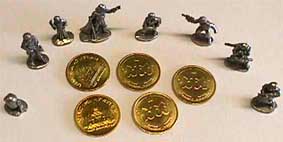 Edition: Star Wars/La Guerra de la Galaxias, Art.Nr. 40786105 Edition: Star Wars/La Guerra de la Galaxias, Art.Nr. 40786105
Publisher: Parker Bros./Hasbro Inc. -
1997
Dimensions of the box: 25.7 x 51.0 x 5.3 cm
The game:
Also this Spanish version is a fine issue of the first Star Wars
Monopoly. It is followed by a few more like "Star Wars-Classic
Trilogy" and "Star Wars-Episode 1".
The most striking of this game are the 2 kinds of players (the Rebellians
and Imperials) each having their own Vehicles and Properties. The
Rules are exactly the same as those of the "normal" game, however
the differences are sometimes striking, viz.:
|
MONOPOLY standard
|
|
STAR WARS MONOPOLY
|
|
6 to 10 tokens like hat, car, boat,
shoe, iron, etc.
|
|
8 Star Wars tokens: 5 Rebels, 3 Imperials
|
|
Streets with title deeds
|
|
Galactic properties and property cards
|
|
Income tax/Luxury tax
|
|
Docking tax/Bounty
|
|
The money = Pesetas/Euro's
|
|
The money = Imperial Credits
|
|
--
|
|
5 "gold" Imperial coins
|
|
Green
houses + red hotels
|
|
2 sets of grey space vehicles
|
|
Chance and Community Chest cards
|
|
Imperials and Rebel cards
|
Each token represents a well-known Star Wars character. The Rebel
Alliance (Rebels) is represented by: Luke Skywalker, Princes Leia,
Han Solo, Chewbacca and R2-D2. The fighters for the Galactic Empire (Imperials)
are: Darth Vader, Boba Fett and the Stormtrooper.
The vehicles of the Rebels are the light gray
X-wing Fighters and Correllian Freighters and those of the Imperials are the
dark gray Tie Fighters and Star
Destroyers.
The banknotes are in various colors with the denomination on the
right side. The text with the illustrations on the banknotes is in Aurebesh!?
The bottom of the box not only shows a clear picture of the game board and
attributes, but also a good picture of the tokens: the "Heroes" and
the "Villains".
This edition is "Frabicado en Irlanda". The price of this set
amounted to € 49,- July 2000.
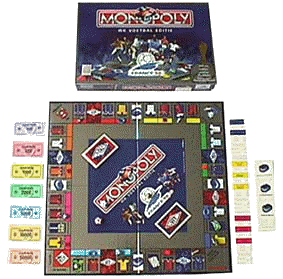 Edition:
Edición
Mundiales de Fútbol, Francia 98,
ref.19618 - Spanish Edition:
Edición
Mundiales de Fútbol, Francia 98,
ref.19618 - Spanish
Publisher: Parker/ Hasbro - 1997
Dimensions: 40 x 27 x 6.5 cm
The game:
This is a box in the colors dark dark blue, silver
and of course red.
The game board spaces can hardly be found on the cover, but so a couple of
soccer players, eachone in an energic posture but not in a match position.
On the bottom of the box is again a clear picture of the game board and its
attributes. Besides it shows that an inner box as football ground is
supplied with the set. It also strikes that the Suerte- and Caja de
Comunidad cards are replaced by Fuera de Casa and En Casa cards,
with of course matching texts like:
 |
Transfer to Brasil |
 |
You
have missed a penalty. Pay 2000 fine |
The bankers tray is of soft dark blue
plastic and has a special space for the square game board. In this game the
properties are of course national football teams, viz. those of the 22 best
clubs of the official worldlist as it is composed by the FIFA on the basis of
the results of the countries in all worldcup finals since 1930. On the game
board they are respectively:
Scotland - Switserland
- Rumenia - Chile
- Mexico - Belgium
- Austria - Tsjecho-Slovakia
(?) - The Netherlands - Poland
- Hungary - Jugoslavia
- France - Sweden
- Uruguay - Russia
- SPAiN - England
- Argentina - Italy
- Germany and Brazil.
The spaces show a T-shirt of the concerning country.
The stations are replaced by the 4 most important stadiums of
France, viz. Stade de Velodrome of Marseille, Stade du parc de
Princes in Paris, Le Stade de France of Saint-Denis and Stade de Gerland
of Lyon. The 2 public
utilities are now Electric Works and Softdrink Manufacturer (marked by a
red beaker but not of Coca Cola). It is remarkable that one can be
sent to Jail in this game as well. The 8 tokens are resp. a shoe, cap, beaker,
hamburger (?), goal, whistle, ball and the (gold colored) FIFA Worldcup
Trophy (with the mark "1974 FIFA TM© in the base).
Other differences with the standard Monopoly game are:
|
MONOPOLY
|
|
ED. MUNDIALES DE FUTBOL Francia
98
|
|
Income tax
|
|
Transfer costs
|
|
Green
houses and red hotels
|
|
Red
stands and blue stadiums
|
|
Sixsided dice
|
|
Football dice (all figures double)
|
|
The money is f.e.Pesetas or Dollars
|
|
The money has no currency
|
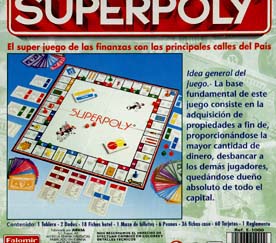 Edition: Superpoly®De Luxe, ref. 1000 (2) Edition: Superpoly®De Luxe, ref. 1000 (2)
"El super juego de las finanzas con las principales calles del País"
Publisher: Falomir Juegos/Jufasa
- 1998
Dimensions of the box: 25.7 x 25.7 x 6.2 cm
The game:
There are but a few minor differences between this set and the issue under the
same ref. number of a few years earlier, viz.:
 |
the lid of the box is blue |
 |
the box is slightly larger |
 |
the back of the solid game board is blue |
 |
the plastic insert of the inner box is white |
 |
the houses and hotels are solidly connected by a pressmould stick instead of a very thin thread |
 |
the little dice are white |
 |
the bottom side of the box shows a color picture of the set with
accessories, see the picture. |
The price of this set amounted to Ptas.3000 (€ 17.98) June 1999.
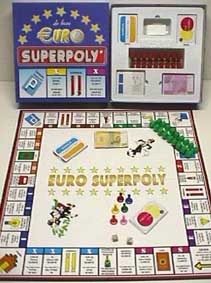 Edition: €uro Superpoly® de luxe, Ref. E-1320 Edition: €uro Superpoly® de luxe, Ref. E-1320
Publisher: Falomir Juegos/Jufasa
- 1998
Dimensions of the box: 25.7 x 25.7 x 6.0 cm
The game:
This is the €uro-version of Falomir's Superpoly® and probably because
of that the color of the box is blue
this time. Also now those 4 random spaces are together under the red
Superpoly® bar on the lid. On the midfield of the solid, double folded game
board with black back is in large gold colored characters Euro
Superpoly surrounded by 18 (?) Eurostars.
Although it is not clearly stated the aim is obviously educative. The
common game has been changed in such a way that the prices of the properties on
their deeds (61x75 mm) are expressed in Euro's only, however, they are in Pesetas
as well on the game board, f.e. "Ramblas 52.000 € = 8.736.000 Pts".
Since the price of this street formerly was 52.000 Pts the price of this
street as well as that of all other properties is increased by a factor 168
because of the introduction of the €.
The insert of the innerbox is of white, soft plastic and contains 6 holes
to store attributes.
The small but nice banknotes (55x85 mm) are not copies of the real
notes. The denominations of
the 6 different banknotes are resp. 200
- 500 - 2.000 -
10.000 - 20.000 and
100.000 €.
The houses and hotels
are of
plastic and connected together by a solid rod. The 6 colored, plastic tokens
are still simple pawns and the white dice are 10 x 10 x 10 mm again.
The (sale?) price of this set amounted to Ptas.1695 (€ 10.19) July
2000.
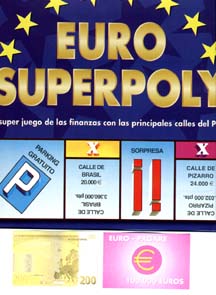 Edition: Euro
Superpoly, Ref. 1500 Edition: Euro
Superpoly, Ref. 1500
Publisher: Falomir Juegos/Jufasa
- 1998
Dimensions of the box: 25.4 x 25.4 x 4.0 cm
The game:
Strange, the lid shows Superpoly (without ® and not in a red
bar) while the board's midfield says Superpoli.
Obviously this is the cheaper version of Ref. E-1320 edition, because:
 |
the double folded board consists of soft cardboard and is
unprinted at it's back. |
 |
all cards are still sticked together on sheets (like with the
Classic edition) and have to be torn loose. |
 |
the insert of black plastic in the innerbox contains 4 holes
and therefor it is somewhat simpler. |
The banknotes, houses and hotels as well as the tokens
are equal to those of the luxury edition Ref.E-1320.
The price of this set amounted to Ptas.3000 (€ 17.98) June 1999.
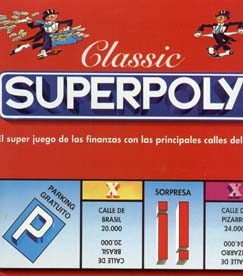 Edition:
Classic Superpoly Edition:
Classic Superpoly
Publisher: Falomir Juegos/Jufasa
- 1998
Dimensions of the box: 25.4 x 25.4 cm
The game:
Because the color of the lid is red this
time the name Superpoly® is only in this issue in a blue
bar. This edition is obviously the cheaper version of Superpoly® Deluxe
Ref.1000.
The differences are:
 |
the board is made of one-side printed soft cardboard. |
 |
all cards stick together as sheets. |
 |
the insert of the inner box consists of a profiled piece of red cardboard with the word Superpoly® in white on the mid part. |
 |
the houses and hotels stick together by solid rods. |
The small dice are white with black pips.
The price of this set amounted to Ptas.2300 (€ 13.80) June 1999.
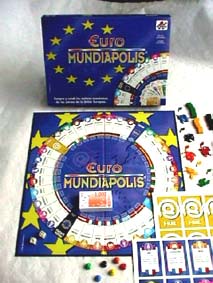 Edition:
€uro
Mundiapolis, Ref. 24551 Edition:
€uro
Mundiapolis, Ref. 24551
"Compra y vende los sectores económicos de los paises de la Unión Europea."
Publisher: Borrás Plana, S.A. - Mataró - 1998
Dimensions of the box: 29 x 40.8 x 5.2 cm
The game:
The publisher of this very nicely performed set says the aim of this game
is:
"To initiate players in the world of international trade the European in
particular, through which they are enabled to enlarge their power and fortune by
ruling over economic sectors in the countries forming the European Community.
And so he is much earlier on the market with this monopoly-like edition than
Hasbro with its Monopoly-Euro Edition."
It concerns 32 economic sectors in meanwhile 15 countries of the E.C.
They are places in a circle on the solid game board in which the Jail is
precisely opposite Salida (Start). However, it is a very special one:
the European Jail for Economic Offences.
Furthermore there are:
 |
An e-mail space where you must take a card with a message
transferred by electronic post! The instructions are like:
 |
Ecology imposition: Pay 1,000,000 € for the pollution your industries
causes. |
 |
You have to appear for the European Tribunalon because of an economic
irregularity. Go directly to the European Jail. |
|
 |
An International Airport. From there you may fly to the space you
have not yet in possession or to the space where you want to place an
establishment or flag. |
About half of the 32 properties are dealed amongst the players at the
start of the match, so 8 cards with 2 players and only 2 with 6 players. These
32 properties are distributed over the spaces as follows:
|
4x Automation
|
2x Mechanical Engineering
|
2x Fishery
|
|
3x Chemistry
|
2x Wine industry
|
2x Textile industry
|
|
3x Tourisme
|
2x European Services
|
2x Oil industry
|
|
3x Electronics
|
2x Mining
|
|
|
3x Agriculture
|
2x Fashion
|
|
The 15 countries of the E.C. are: Portugal (1x) - Spain (3x) -
Italy (3x) - Belgium (1x) - Denmark (2x) - Greece (1x) - France (4x) - Austria
(1x) - Holland (3x) - Sweden (2x) - England (3x) - Luxemburg (1x) - Ireland (2x)
- Germany (4x) and Finland (1x).
After you have obtained the ownership of an industry you have to construct an establisment
next time you land on that space. Finally you can put a flag on the
building the next time you land on it. So your profit increases when an other
player lands on your space.
The one side printed white banknotes (in Euro's as well as in Pesetas)
have the 7 denominations: 1.000 - 5.000 - 10.000 - 50.000 - 100.000 - 500.000
and 1.000.000. When you land precisely on Salida you do not only get 200.000 €
but in addition all the money from the pool on the centrefield of the game
board.
Like at Petropolis (see "Mexico") this game is also divided into 3 stages:
1st stage:
In this stage the point is to collect as many properties as possible. It ends
the moment there are still 6 unsold properties. Then Pause set in.
Pause:
-
The remaining 6 properties are auctioned and the players can negociate
to complete their groups.
-
Negociation is only allowed in this Pause.
3rd stage:
Main match during a predetermined time. One hour is recommended. The
e-mail cards may only be used from this stage of the game.
The inner box contains an insert of black plastic with one large hole
and 3 smaller holes for the money and the card. On the bottom side of the box is
a nice color picture showing the whole set.
The price of this set amounted to Ptas.3750 (€ 22.47) June 1999.
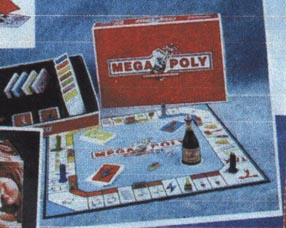
Edition: MEGAPOLY
Publisher: PJ popular Juguetes
?? - 1998
Dimensions of the box: nog onbekend
The game:
Although I have only seen this set in a catalogue and consequently I'm not be
able to describe it, I think it interesting to show a picture. Hence the
accompanying scan of a picture shown in the catalogue.
The price of this set amounted to Ptas.8000 (€ 47.93) August 1999.
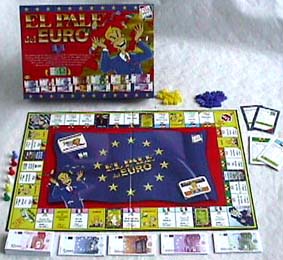 Edition: El
Palé del Euro, nr. 34.608 Edition: El
Palé del Euro, nr. 34.608
"The game of finance with Euro's"
Publisher: CEFA Toys
S.A.- Zaragoza - 1999
Dimensions of the box: 27.0 x 37.2 x 6.5 cm
The game:
This very interesting and thoroughly produced game of inland manufacture has a
very characteristic nature. On the one side it clearly contains features of a
monopoly game, like:
 |
8 groups of streets with property deeds. |
 |
a Jail (with a very strong rascal who can bend the bars!). |
 |
a somewhat silly looking policeman-with-cudgel who uninterestedly directs
you back. |
 |
a Free Parking space with Stop sign instead of the well-known car. |
 |
a stack of Tarjetas Suerte (Luck cards) and Tarjetas Sorpresa
(Surprise cards). |
 |
a laughing-man-carelessly-scattering-banknotes like he is Rich Uncle
Pennybags. |
On the other hand there are remarkable differences like:
 |
the rectangular shape of the game board with but 8 spaces on the short
sides 1 and 3 and 12 spaces on the long sides. |
 |
the 6 VIP's spaces instead of 4 stations and 2 utility
fields. |
The Rules say the streets are from European capital cities. However,
if we consider below statement 2 things show up, viz.:
-
There are but a limited number of countries of the European Community
"chosen".
-
Spain has 2 capital cities (?), namely Madrid and Barcelona!
Starting from Salida the countries and their streets are subsequently (see
the many styling errors):
Portugal = Lissabon: Praça Rossio - Avenida da Liberdade - Praça dos
Restauradores
Germany = Berlin: Tiergarten - Kurfürstendamn - Alexander Platz
Belgium = Brussels: Gran Place - Rue Americaine
Austria = Vienna: Philharmonike Strasse - Kärntner Strasse
Spain = Barcelona: Plaça Catalunya - Passeig de Gracia - Avinguda
Diagonal
Spain = Madrid: Plaza Mayor - Paseo de la Castellana - Avenida de la Gran
Vía
Italy = Rome: Piazza Venezzia - Piazza di Spagna - Vía Veneto
France = Paris: Boulevard des Montparnasse - Rue de la Paix -
Avenue des Champs-Elysées
The 6 VIP's spaces (well-known buildings and structures) are resp.: Basílica
di San Pietro (Vatican) - Tour Eiffel - Estadi Olimpic Montjuic - El Muro de
Berlín - Santiago Bernabéu and Opera de Viena. Although the property cards of
these have a blue border with 12 stars they
are naturally no European capital cities.
As the name of the game, as well as the year of issue, make suspect the introduction
of the Euro is involved. All prices are stated in Euro as well as in Peseta,
but the very nice looking banknotes are in Euro only. The denominations
are resp. 5 - 10 - 20 - 50 - 100 - 200 and 500 €.
The plastic houses are dark blue and
the hotels are yellow. The 6 tokens
are simple aggravation pawns and the 2 very tiny (9x9x9 mm) dice are
white. The bottom of the box shows a picture of the game board with all its
accessories as well as a short description of the game.
The price of this set amounted to Ptas.4000 (€ 23.97) June 1999.
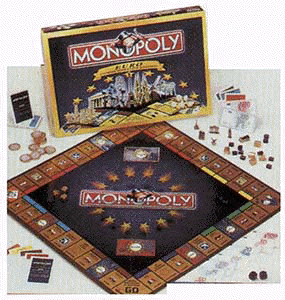 Edition: Monopoly
Euro, ref. 05597 - Spanish Edition: Monopoly
Euro, ref. 05597 - Spanish
Publisher: Parker/Hasbro, Inc. - 1999
Dimensions of the box: 27.0 x 40.2 x 6.5 cm
The game:
Of course Parker/ Hasbro took the
opportunity of the introduction of the Euro to issue a special edition again.
Was there in 1991 talk of but 12 countries of the European Community (see
the description of the game in the "blue
box"), now 15 countries belong to the European Community and 7
countries will join in the years to come. The makers of this game already
anticipated by situating these countries at the beginning of the game. The most
expensive properties are the capital cities of the countries who were
first to become member. Groups who became member together are partitioned to the
size of their capital population.
The capital cities and countries are from Salida on:
Vilnius (Lithuania) - Riga
(Latvia) - Sofia (Bulgaria) - Bukarest (Romania)
- Warsaw (Poland) - Boedapest
(Hungaria) - incorrect!> Genève (Switserland)
- Helsinki (Finland) - Stockholm
(Sweden) - Vienna (Austria) - Lisbon (Portugal)
- Madrid
(Spain) - Athens (Greece) - Dublin (Ireland)
- Copenhagen
(Danmark) - London (United Kingdom)
- Luxemburg (Luxemburg)
- Brussels (Belgium) - Amsterdam (The Netherlands)
- Rome
(Italy) - Berlin (Germany) and Paris (France).
The 4 stations became the 4 busiest airports of Europe, namely
Schiphol (Amsterdam) - Rhein-Main (Frankfurt) - Paris Charles de Gaulle and
London Heathrow. Both utilities became: the European Parliament and the
European Court of Justice.
It is a pitty that there are but 8 tokens this time, a very poor choice out of 22
countries. Seven of these tokens are the same as those of the
1991 edition. Only the Atomium from Belgium has been replaced by Manneke Pis.
And why are these pewter tokens not as nicely gilded? The carefully edited
booklet of the Rules give a detailed explanation of these tokens.
The 7 different banknotes are nice copies of the real €-notes. De € 1's
are gold and silver colored (plastic) coins. On or over Salida you receive € 200. There is no explanation given why the plastic houses with roof edge
and chimney are dark blue now and the hotels
gold brown. Both the dice are dark
blue with gold pips.
Worthy mentioning is the fact that the lid now shows a part of the Go-space with a part of the first and fourth side in perspective. That is
remarkable because this same presentation is also applied by all City Games of
Winning Moves Int. who are issued in ta number of European countries since 1998. The bottom
of the box shows again a nice color picture of the gameboard with all its
attributes.
It is obvious to put the differences and similarities with the
European Edition of 1991 on a row:
|
Monopoly Euro
1999
|
Monopoly European Edition 1991
|
|
folded twice gameboard in a rectangular box
|
folded twice gameboard in square box
|
|
properties are capital cities of 22 countries
|
properties are groupes of 2 or 3 streets of 8
countries
|
|
"stations" are airports
|
"stations" are airports
|
|
in jail is .... Jack the Jailbird
|
in jail is …. nobody
|
|
the currency is Euro
|
the currency is Ecu
|
|
8 tokens of well-known buildings
|
12 tokens of well-known buildings
|
|
Mr.Monopoly in the red
bar
|
Rich Uncle Pennybags in the red
bar
|
|
nothing written on the back of the board
|
Monopoly in silver on the back of the board
|
The catalogue price of this set was Ptas.6795 (€ 40.84) August 1999.
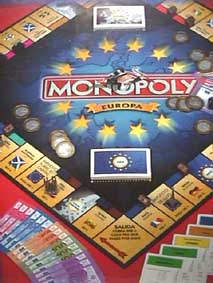 Edition: Monopoly
Europa Edition: Monopoly
Europa
Publisher: Parker/Hasbro, Inc./Hasbro Iberia
S.L. - 2001
Dimensions of the box: 6.5 x 26.8 x 40.1 cm
The game:
After the edition with ref.nr. 05597 was launched it appeared that the
Hasbro design department didn't knew what the capital of Switserland is.
They had put the important town of Genève amongst the capital cities
of other European countries. It took, however, 2 years before this new edition,
with a new ref.nr. as well as a new appearence (enlarged tokens on the lid and a
banner showing "Europa") was issued mentioning the right Swiss
capital of Bern.
All the rest of the game remained unchanged.
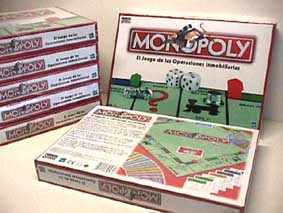 Edition: Standard - Madrid, ref. 00009/105 Edition: Standard - Madrid, ref. 00009/105
Publisher: Parker/Hasbro, Inc./Hasbro
Iberia S.L. - 2001
Dimensions of the box: 26.8 x 40.3 cm
of the game board: 25.2 x 25.2 cm
The game:
Parker/Hasbro are more and more
standardizing their editions worldwide (what makes them the less interesting for
collectors to my opinion). Now all standard editions off all countries have the
same number 9, the number used for the American standard editions from the first
1935 issues on.
The design of this new edition characterize by:
 |
The illustration on the lid shows a somewhat cheap red
rim. |
 |
Only 4 spaces of the fourth side of the game board are shown in perspective with 1 house, 1 hotel, still the hat and
the racecar
as well as both dice, however now with 4 and 3
(instead of 3 and 5). |
 |
The perspective red Monopoly bar with
the nice shadow and Mr.Monopoly with the red bow tie (until 2000
he was Rich Uncle Pennybags), that appears on the lid, the
board game's midfield and all 4 rims of the innerbox. |
 |
The bottom side of the box no longer shows "the laughing
family" but almost the whole game board with all its attrubutes. |
The "banker's tray" of this "standard"
box is red again and has holes
for the 7 banknotes as well as for the property deeds who are still present with the banker.
The game board is folded in four and fits, when stored,
precisely on the banker's tray. The back of the board is as usual red,
the playside is blue green.
On the board the Suerte cards with red
back and ? are as usual next to the Salida corner and the
Caja de Comunidad cards with blue back
and treasure chest next to the Free Parking corner. The cards (56x87
mm) have round corners.
The property cards (56x87 mm) also have round corners.
The banknotes (52x100 mm) are printed on one side only. On top
of the circle on the note is a black ribbon showing "MONOPOLY with
Mr.Monopoly". At the bottom of this circle is in small characters "©2001 Hasbro
Inc.". The currency is Euro (€) and the denominations are resp.:
1 - 5
-10
- 20 - 50
- 100 and 500
(ref.100 00009 00C0).
The 10 tokens are of light metal and are the well-known: hat -
shoe - car - boat - dog - wheelbarrow - rider-on-a-horse - thimble - iron and
canon.
The green houses
and red hotels
are of non-transparant plastic and have all an overhanging roof with an
excentric chimney.
Both dice are white with black pips.
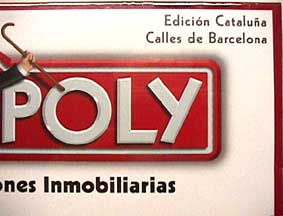 Edition:
Standard - Barcelona, ref.
00009/118 Edition:
Standard - Barcelona, ref.
00009/118
Publisher: Parker/Hasbro, Inc./Hasbro
Iberia S.L. - 2001
Dimensions of the box: 26.8 x 40.3 cm
of the game board: 25.2 x 25.2 cm
The game:
The Catalan edition has also been issued in the new standard version of the
box-with-red-rim with the streets of
Barcelona.
For the rest all details are exactly the same as those of the Madrid edition.
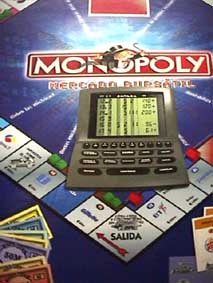 Edition: Monopoly -
Mercado Bursátil, ref. 16465/105 Edition: Monopoly -
Mercado Bursátil, ref. 16465/105
Publisher: Parker/Hasbro
Inc./Hasbro Iberia, S.L. -2001
Dimensions of the box: 6.5 x26.8 x 40.1 cm
The game:
The most particular of this game is the computer that goes with it
(however without batteries). The slogan of this Stock Exchange game
is: "Buy for as low a price as possible and sell
for substantial prices!"
Everything is simplified with this computer for the players (every player has
his own entrance button). So they can calculate the exchange rate of their
shares and store the "Presidencies of their compagnies".
The properties of this game are international and national
compagnies that may differ per country. A few names of the 22 Presidencia's
( Presidencies),
4 Medios de Comunicación (media)
and 2 Compañias Energéticas are:
Gillette (01)- Unilever (02)
- Antena 3 - Marks & Spencer (08) - COPE
- Burger King (11) - El Mundo -
Electrolux (15) - Nokia (20)
- SER - Telefonica (21) and BT (22).
Chance has been replaced by 16 Baja (falling)
cards and Community Chest by 16 Alza- (rising)
cards.
The values of the banknotes are a factor M (million)
higher and at Salida you will receive € 200M. The denominations of
these Monopoly banknotes are resp.:
1M - 5M
-10M
- 20M - 50M
- 100M and 500M.
The 6 tokens are unfortunately the common metal tokens boat - dog - car -
hat - shoe and iron.
The grounds are built with
32 Sucursales (branches)
and 12 Oficinas Centrales (main
settlements).
Both dice are white with black pips.
|